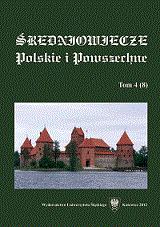Unsere liebe Fraue. Wspólnota miasta i kościoła w Krakowie w XIV wieku
Unsere liebe Fraue. The community of town and church in Cracow in the 14th century
Author(s): Jerzy RajmanSubject(s): History
Published by: Wydawnictwo Uniwersytetu Śląskiego
Summary/Abstract: The Church of Saint Mary performed a function of the parish church in Cracow as early as in 1224. The town location on the basis of the Magdeburg law was conducted in 1257 in such a way to situate the St. Mary’s Church in the corner of the market square, by means of which its place was exposed. It became the main church of the bourgeois district. The parish of the St. Mary’s Church included most of the locative town area. Probably, as early as at the beginning of the 14th century, the chapel was known for being carefully taken care of by the town council in Cracow. Formally, the patronage law belonged to the bishop in Cracow, but, virtually, it was the town council that made decisions when it comes to issues connected with building and equipping the Gothic church. Special church carers (vitricus) started their activity on behalf of it as early as in the first half of the 14th century. The new church building, began at the end of the 13th century and continued (with important architecture changes) throughout the 14th century was financed by the town council and the bourgeoisie from Cracow. The biggest contribution is ascribed to Mikołaj Wierzynek, called the Older, who founded a chancel being an exposed zone for town councilors from Cracow. The St. Mary’s Church became the most outstanding church in Cracow, efficiently competing with both the cathedral, and churches in Kazimierz nearby founded by king Kazimierz Wielki due to its rich architecture programme. The St. Mary’s Church became the manifestation of the role of the town council in Cracow and the bourgeoisie. As early as in the 14th century, particular bourgois families funded altars and chapels (e.g. the Wierzynek, Krancz, Salomon, Welker and Trutil families), as well as the objects of the liturgical equipment. The dedications of these altars reflect a very rich religious programme. Inside the church there were the God’s grave yard and organs. Probably in the first half of the 14th century the brotherhood of St. Mary was founded, covering the bourgeoisie from Cracow. It possessed its own chapel and confessor. Besides, the St. Mary’s Church included a chapel where the last spiritual services were given to those sentenced to death.
Journal: Średniowiecze Polskie i Powszechne
- Issue Year: 2012
- Issue No: 8
- Page Range: 150-201
- Page Count: 52
- Language: Polish

